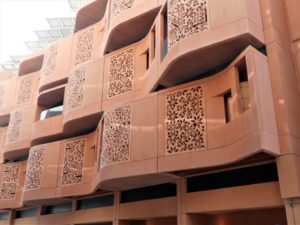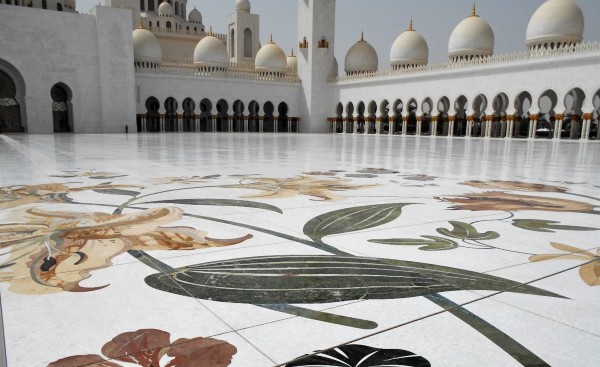
By Ellen Shubart, Class of 2006
We couldn’t resist the opportunity to go to the United Arab Emirates with CAC, and to view the architectural canvas that’s luring many American and world-renowned architects. The UAE was using their Expo just as Chicago used its 1893 Fair: to boost its image, make its play to be a world-class city and to gather tourists to its shores. Originally, the Expo was scheduled to start in October 2020 and end in April 2021. But it was postponed due to the COVID-19 pandemic, with the organizers retaining the name Expo 2020 for marketing and branding purposes
On Feb. 27, 2022, we boarded an Emirates Airlines flight for a 13-hour trip to Dubai, the first stop on a week-long trip with architecturally minded folks, now our friends. We visited three of the seven united Arabic-speaking states, two of which predominate: Dubai and Abu Dhabi. You may think you’re going to the desert, but there’s lots of water in this land on a peninsula in the Persian Gulf. As we were repeatedly told, 50 or 60 years ago this land was sand. Today it is not just a skyline, but two entire cities filled, no, stuffed, with high-rises, skyscrapers and architectural masterpieces. And it all happened in a very short time.
Abu Dhabi
Abu Dhabi went from a population of 4,000 in 1950 to 1.2 million people today. That is significant growth. With it came people from all over the world – only 15 percent of the population is made up of native Emiratis. The rest come from all over, but primarily from southeast Asia, Pakistan, Bangladesh, Philippines and Africa. Our in-country guide was, for example, Sri Laken, who had been living in the UAE for 25 years. (The guide from the travel agency was Spanish and he lived in Barcelona.) Our guides for specific tours were from Canada (an architect who came for one project and stayed for over 25 years to work on many projects), Uganda, Nepal and Lebanon.

Our Canadian architect noted that, in his Dubai neighborhood – not in the entire town – there were six high-rise buildings when he arrived. Today, there are 120 in his neighborhood alone! Skyscrapers are all over. Architecturally, he called many of them “towers with a party hat on,” but he also noted how many have facades created to shade the buildings from the intense heat. Glass alone often is not enough to protect these buildings.
A Muslim Society
The society is Muslim, but not overwhelmingly so. The women wear the black robes and hijab head coverings, but do not cover their faces. They often let some of their hair show under the head scarves. We saw very few native people and, certainly, no women walking on the streets. But at the 2020 World Expo, there were many families with moms in black robes, dads in white robes, and kids dressed like most kids worldwide.
The only religious building we were allowed to enter was the Sheikh Zahed Grand Mosque in Abu Dhabi, the only one open to non-Muslims. It is spectacular, a vision in white marble with inlaid mosaics of flowers, gold and semi-precious jewels throughout. It was not the only place where we saw unlimited supplies of gold, which is visible all over and particularly at the Emirates Palace, an extensive building now used as a hotel in Abu Dhabi. Mosques are everywhere, as it is required by the Quran that they be close to all neighborhoods. But they were not open to us.

Michael Calatrava, Santiago Calatrava’s son who worked with him on the spectacular UAE Pavilion at the Expo, began his lecture by noting that the UAE today is the “center of the world”: nine hours from Europe, Russia, China, India, Africa and even South America. (Notice which continent and countries are not mentioned.)
Expo 2020’s Most Impressive
There were 191 countries represented at the Expo. We toured 30 of their pavilions in the three half-days of our visit. The most impressive attractions at the Expo appeared to be the permanent buildings, i.e., those not to be razed after the Expo closed on March 31, 2022. Designed to be part of a new neighborhood in Dubai, they included:
* Gordon Gill’s remarkable Al Wasl Plaza, an open-top dome, a structure of steel and fiberglass fabric that will house a community garden. The plaza sparkles at night when it is lit by more than 250 projectors that show designs and stories (like you saw at the 2010 Winter Olympics opening ceremony where the whales “swam” on the ceiling);

* Santiago Calatrava’s UAE Pavilion of white marble with Calatrava’s signature “wings” design. Each wing holds solar panels that open and close to accommodate the sun;
* Two hotels and many two-to-three-story buildings that housed the exhibits of smaller countries that will remain as hotels and/or become offices or apartment buildings.
* One of the most impressive attractions was the Singapore pavilion, made entirely out of plants, each in a pot with an irrigation pipe — a monument to “green” innovation and sustainability.
There were no shortages of “great ideas,” including:
* Sweden’s pavilion of wood stressed the use of wood over steel and/or concrete, and the possibility of reuse for sustainable development;
* The Netherlands pavilion handed out umbrellas, then aired its video on the “screen” at the top of the open umbrellas;
* France featured croissants and Belgium waffles in their cafes;
* And Slovenia pushed its message that it was the only European country with “love” in its name.
Museum of Future
In Dubai, we saw a marvelous new museum, the Museum of the Future, designed by Killa Design with engineering by BuroHappold. A major emphasis is on space travel to Mars and beyond. (The UAE’s space agency is run by a woman, who is the equivalent of the administrator of NASA in the U.S.) The rest of the seven-story museum looks at transportation alternatives. The building is an oval “donut,” complete with a hole in the middle. Its façade features a poem, rendered in steel, by Dubai’s ruler, Shiekh Mohammed Bin Rashid Al Maktoum. Reputedly, the Sheikh can look from above and see in the metal calligraphy the inscription for “Innovation.”

The food? Very good and very much in the Mediterranean/Greek style. We ate lots of humus, lamb and grape leaves. The chief Emirati food is a version of the Indian Muslim’s biryani, a rice dish with lamb, veggies, chicken and everything but pork. Lots of water is drunk, both to keep you hydrated and because alcoholic drinks are offered only in hotels. (Again, this is a Muslim country.)
The Desert
Our tour went to the desert for a half-day/one-night stay in a deluxe resort with five pools overlooking the sand dunes. The huge buffet dinner in a tent offered foods from all over the world, in addition to those of the Middle East and Asia. The after-dinner floor show included a whirling dervish from Turkey, Armenian folk dancers and a belly dancer. A camel, horse and goat (all live on the sand stage) helped enliven the story told of the settlement of the UAE. The worldly audience — except for most of our CAC group — happily smoked hookah pipes as they ate and enjoyed the show.
Also in the desert, near Abu Dhabi, is Mansard City, designed to be a self-sufficient settlement complete with electricity, air conditioning, heating and other amenities of a modern, sustainable city. It is a university campus, too, and the Siemens manufacturing company just moved its international headquarters from Germany to Abu Dhabi. (It says a lot about where the action is re technological advances re sustainable development.)

Burj Khalifa
Adrian Smith’s Burj Khalifa skyscraper in Dubai is as spectacular as you think it will be. Its half-mile height overwhelms. The elevators zip up to the 124th-125th floors, which have indoor and outdoor observation decks with 360-degree views that show you how the city has spread out. Large areas are filled with skyscrapers next to huge acres of sand, just waiting for more development.
In all… it was a fascinating tour. Thus far, the United Arab Emirates has done little to celebrate its historical heritage. In Dubai, we stayed in the area of the old city, which meant that we were in a hotel in a reconstructed desert/Arabic-style souk (marketplace). We heard about the nomads in the desert and the pearl fishers in the Persian Gulf, but few museums focused on their history. We found little to no original handicrafts. Souvenir shops, yes, but selling souvenir-style junque — while huge indoor malls boasted most of the familiar worldwide shops, including Faberge, Hermes, Dior, Chanel and even a giant IKEA. At the entrance to the Grand Mosque, we encountered an old friend, McDonald’s.

CLICK HERE for more stories on The Bridge.


Ellen,
An outstanding recap of our Middle Eastern adventure–brava!!
Nancy
Fascinating and exciting. What a trip!
Wow! Felt like I was there, without the jet lag. Thanks
Wonderful re-cap! I too feel as if I was there!
Well done! Felt like I was on the trip with you.
Very interesting. I had never been interested in travelling to these cities but maybe I will re-consider.
Incredible reporting! Love all the personal touches you shared about your amazing experience. Suzy Ruder
Wow, what a great trip Ellen. Your descriptions and photos are just fantastic! I also have started considering taking a trip there.
Ellen, thanks for sharing your photos and astute observations! What a magnificent trip! Elizabeth Peterson Hall
This is trip has long been on my bucket list! Great story and pictures!
Marcia Ross
What an interesting and vivid description of your trip, Ellen. And kudos to Richard for the terrific pictures.
Thank you Ellen for an entertaining recap of your recent trip to the Middle East.
peace